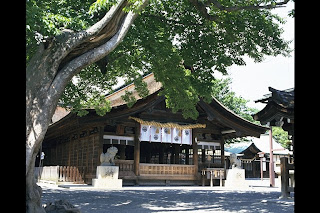Owari Okunitama Jinja (Konomiya Jinja) UC
 |
| Owari Okunitama Jinja haiden (photos courtesy of the shrine) |
Address: 1-1-1 Konomiya, Inazawa-shi, Aichi 492-8137
Tel/Information: 0587-23-2121
How to get there: Take the Meitetsu Nagoya Honsen line train from Nagoya
Station to Konomiya Station, then 3 minutes on foot. Or the JR Tokaido Line from Nagoya Station to
Inazawa Station and then 15 minutes on foot.
Enshrined kami: Owari Okunitama no kami (Okuninushi).
Prayers offered: Protection from danger (yakuyoke)
especially in the ages of greatest danger (yakudoshi) which are age 25, 42 and
61 for men and 19, 33 and 37 for women plus one year before and after.
Best time to go: During the main event at the shrine, the
Hadaka Matsuri in January, and during cherry blossom season from late-March to
early-April.
 |
| Torii, sando and romon |
Important spiritual features: This shrine is dedicated to
Okunitama no kami which is said to be another name for the rough spirit (aramitama) of Okuninushi. The shrine
was founded sometime in the early Nara period but an ancient stone alter
(iwakura), a place where the kami is said to descend to the earth, is located on the shrine grounds. The five stones are set
out in a circle and according to shrine tradition, the rock formation is over
two thousand years old. The majority of such iwakura remaining in Japan are
from the Jomon period and their significance is a matter of speculation. Though some claim that iwakura were places for the kami to descend, thereby insinuating that Shinto is as ancient as Japan itself, others think they may have has a place in funerary or other specific rites. However there is no question that both Shinto and Buddhism often located their places of worship on ancient sites that were used for some form of worship and Konomiya Jinja was no doubt one such place.
 |
| The "Naked Man Festival" (hadaka matsuri) |
Today, Konomiya Jinja is known
nationally for its “naked-man” (hadaka) matsuri. Tradition has it that this
festival first took place in 767AD, making it over 1200 years old. It was
instituted in an attempt to ward off a plague and is properly considered a festival to exorcise bad spirits, but it is also a celebration of
male virility. There are many such festivals in Japan with Konomiya perhaps the
most famous, attracting thousands of male participants and some 300,000
spectators each year. Participants wear strips of colored cloth called naori
gire to ward off evil. Such festivals are purification rites meant to remove
impurity and open a path to good fortune. Basically, one man is chosen to be the
“god-man” (shin otoko) who is designated to remove the pollution of the entire
town. He does this by having thousands of men considered to be in the unlucky
years (yakudoshi) touch him, transferring their bad luck to him. It is an honor
to be chosen as the shin otoko—a scapegoat—who must be isolated within the shrine for three days
before the festival, have his hair shaved off, and be fed on rice gruel—all in
order to purify himself. The mostly heavy-drinking participants (they are running
around almost naked in the middle of February after all), carry long bamboo
poles covered with papers with the “excuses” of people who couldn’t make it to
the festival, which they deposit at the shrine. When the shino otoko appears,
these naked men basically cause a riot by trying to all reach the him at the same time. The shin-otoko's guards attempt to stop him getting
killed in the resulting mayhem by throwing cold water on the crowd (the
participants throw water on each other as well), until the shin otoko can pass
through the crowd and in through a small opening in the shrine to end the
festival. A man, tethered to a rope, is often sent out from the shrine to
“rescue” the shino otoko. The next morning at 3am, he carries a dohei shinji (a
cake of mochi rice mixed with ash) on his shoulders while being chased by
visitors throwing small pebbles at him. The cakes have candles in them and if
one should blow out it portends misfortune throughout the year. The dohei is
then buried, symbolically burying the pollution and purifying the town for
another year. A number of huge kagami mochi (a hard, dried rice-cake stacked
three high, 6.5 feet tall and wide and weighing about 2 tons) is also prepared
and cut into pieces to be distributed to visitors. As with many Shinto
festivals, designed to take participants from the profane to the sacred world,
a certain amount of sheer madness is required. The Hadaka Matsuri of Konomiya
Jinja certainly fits that bill.
 |
| The "Naked Man Festival" (hadaka matsuri) |
No comments:
Post a Comment